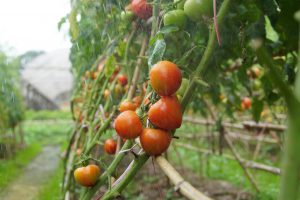By Sarah Bostick and Carol Wyatt-Evens
Gardening in Florida can be incredibly rewarding and incredibly frustrating at the same time. If you are new to the region, you soon learn that gardening in the sunshine state can quickly become a full-time job. Our subtropical climate is perfect for growing an abundance of different vegetables, fruits, and herbs, but the challenges can sometimes be a bit overwhelming.
This is where we can help! Agents from UF/IFAS Extension Sarasota County have partnered to offer a weekly, 30-minute workshop on Zoom to help answer your gardening questions. The first 10 minutes offers an educational component relevant to the urban gardener. The remainder of the time is dedicated to question and answer – any question you have! The series runs through March 2021 with the exception of holidays. You must register for the series on Eventbrite to receive the link to the series. You only need to register once to get access to the entire series:
Every week, the agents will post a question from the webinar that we are sure will be helpful for our community gardeners at large.
This week’s Question of the Week is:
Tomato-growing aids: trellises, plastic mulch, and other products
We are doing our blog posts a little differently this week! Rather than focusing in on one topic, we are answering all of the questions asked our Tomato 101 class in a series of four themed blogs. Here is a Q&A for the “Tomato-growing aids” theme:
Q: Do red plastic mulch or wraps really help with tomatoes?
A: To a large extent, the verdict is still out on whether or not red plastic mulch helps tomatoes ripen more quickly. In addition to red plastic mulch, there are many other colors of plastic mulch, all of which have been designed for a different set of growing conditions. If you would like to learn more about different colors of mulch, the University of Connecticut has a handy resource.
Q: For taller tomatoes, I wire-tie two larger size tomato cages together, and sometimes add a stake for extra stability. Do you have other recommendations for DIY tomato support structures?

A: There are countless creative ways to provide support for your tomatoes. Although we often talk about tomato “vines”, tomatoes are not vines – they are large sprawling plants that do not have the ability to hold on to structures. To keep tomatoes healthy and disease-free, it is important to keep tomatoes from sprawling on the ground. To do that, we have to create structures to support their vertical growth. You will need to either create some sort of cage or tie the plant to a structure.
This website is home to 53 creative tomato trellising ideas complete with photos, descriptions, and cost estimates. One of the most inexpensive and widely used techniques used in the farming world is called the Florida weave! Read all about it and 52 other techniques.
Q: What do you think of using a “halo” at the base of the plant?
A: There are a LOT of products on the market geared towards helping home gardeners grow the perfect tomato. The best way to figure out if a product works for you is to give it a try. There is very little university research into the effectiveness of most types of tomato-growing aids. If you are interested in doing some of your own research, here are some key words to use in your internet search: “tomato halo”, “tomato ring”, “tomato collar” and “tomato blanket”. Some of these products are designed to increase the heat around your tomato plant – just remember that this is not always a good thing if you live in a hot region of the country!
Q: Is a calcium spray sprayed on tomato fruit really helpful to keep “blossom end rot” from happening?
A: Blossom end rot looks like a terrible disease in tomatoes, but the good news is that it isn’t! It is a physiological disorder in tomatoes, not a disease. It is caused by insufficient calcium in the plant. If you frequently have tomatoes that show the tell-tale signs of blossom end rot, it is time to do a soil test to figure out how to restore sufficient calcium to your soil. You can help a plant experiencing calcium deficiencies make it through the season by using a calcium spray on the leaves. There are various calcium spray products on the market. Follow the instructions on the bottle label closely.
For answers to more common tomato questions, click on the links below:
- Tomato-growing aids: trellises, plastic mulch, and other products
- Tomato troubleshooting: why won’t my tomatoes produce fruit?
- Growing tomatoes in containers
- What do I need to know about tomato seedlings: planting dates, transplant size, and disease resistance?
The Edible Gardening Series and blog series is a partnership between the following UF/IFAS agents and Sarasota County staff:
- Sarah Bostick, Sustainable Agriculture Agent
- Carol Wyatt-Evens, Chemicals in the Environment Agent
- Mindy Hanak, Community & School Gardens Educator
- Kevin O’Horan, Communications Associate
 0
0
